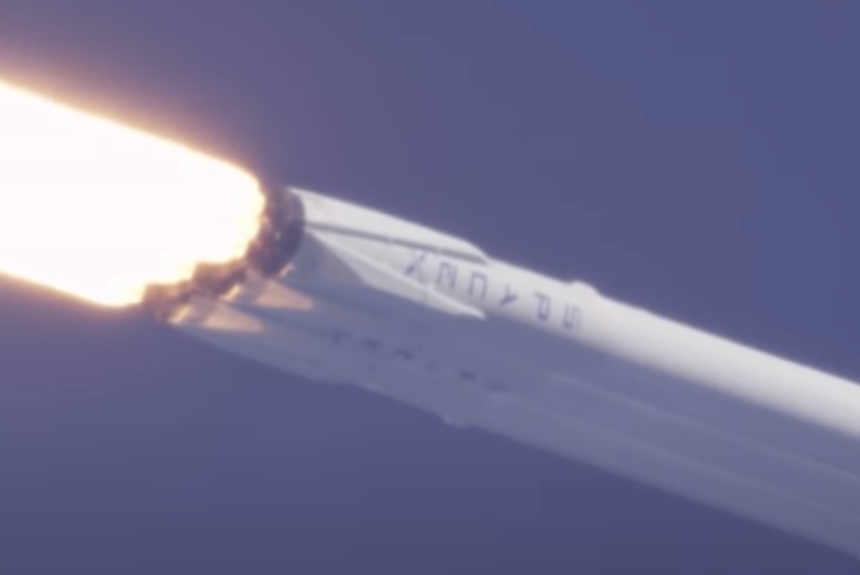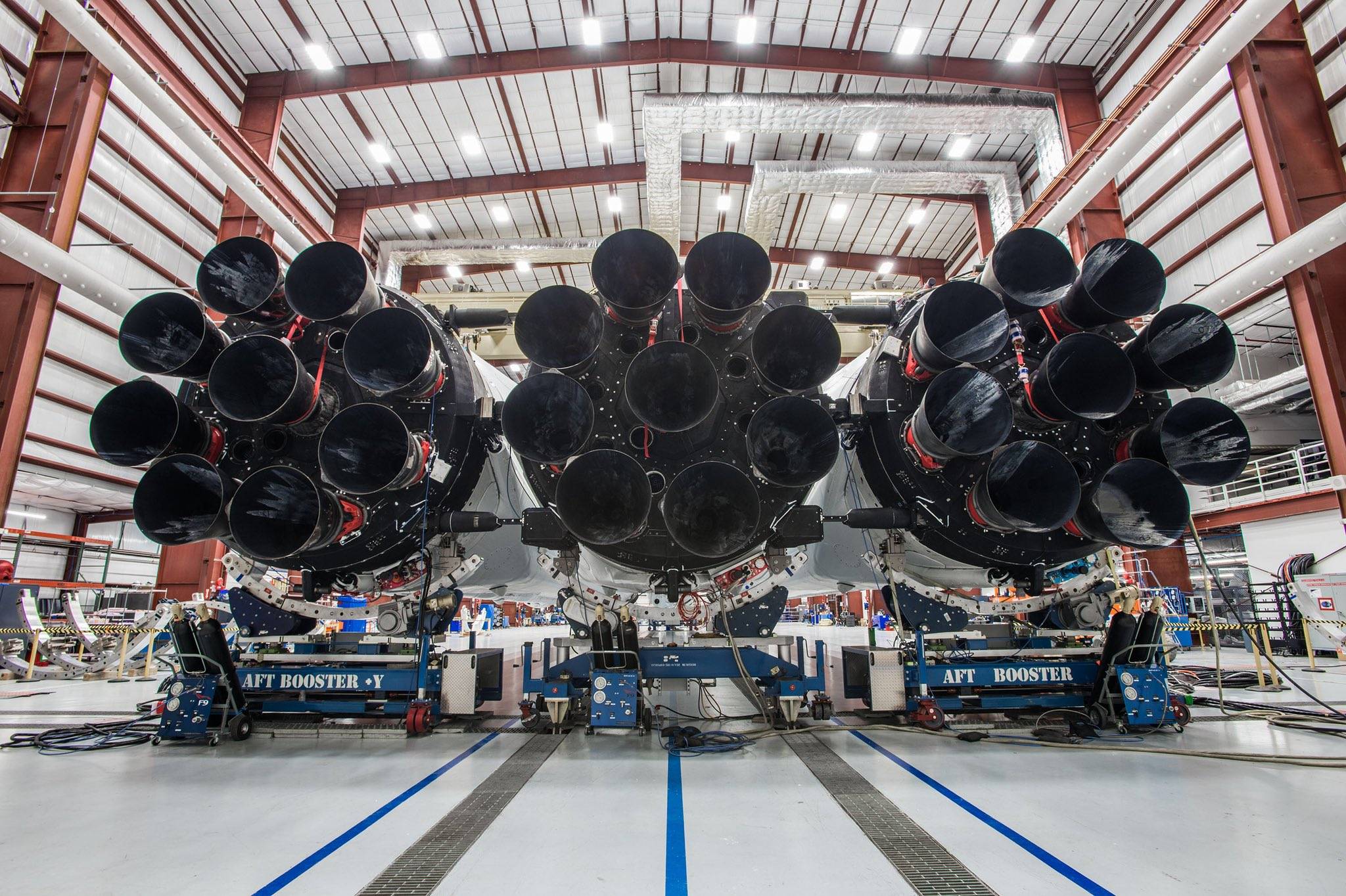- Joined
- Nov 5, 2016
- Messages
- 174
- Reaction score
- 295
On Feb 6, 2018 SpaceX conducted their first Falcon Heavy test flight. They used Elan Musk’s red Tesla Roadster as the payload. You can view the actual launch here. And you can track the current location of the Roadster here.

Here, I present my latest build (3.0) of this rocket at 1:90 scale. This is a three cluster, 2 stage model with booster separation at Booster Engine Cut Off (BECO), second stage ignition at Main Engine Cut Off (MECO), and a Red Tesla Roadster as the payload. This scale allows the use of BT-60 tubes for the core rocket and booster bodies and a BT-70 tube for the payload fairing. The design uses Estes E12-0 or D12-0 motors for the core, and C-6-0 or B6-0 motors for the boosters, with an A8-3 motor in the second stage.
It measures 78 cm high and weighs ~460 grams (without motors)
In the most recent versions of my SpaceX Falcon models, the landing legs extend for an attempt at upright landing of the boosters and core rockets. You can see how the landing looks at the end of this launch of my 1:65 scale Falcon 9 Crew Dragon.
This is my 3rd build of this rocket at this scale. With each build I have added new features and fixed problems with previous builds. Here is the history of my progression of this model:
Build 1.0: used a model Falcon 9 kit from SpaceX for the core, BT-60 tubes and parts from Boyce Aerospace Hobbies for the boosters, and custom made booster mounts and motors. Features included:
This model flew successfully on 11/27/2019. It also flew successfully as a Falcon 9 (without the boosters) on Feb 20, 2020 at a SARG club launch in Sacramento CA.
Build 2.0: In addition to the above, features include:
This model has yet to fly successfully due to repeated cluster ignition failures. It turns out that reliable cluster ignition is hard.
Build 3 (this build): In addition to the above, features include:
*These were first developed on my Space X Falcon 9 Crew Dragon BT-60
**This was introduced on my Falcon 9 Crew Dragon Build 2.0
*** This build still has paint on the nose cones but everything else is White PET plastic or self adhesive paper printed on a color printer.
I plan to do the first flight of this model at that SARG club launch on April 23rd 2022.
Photo of (almost) all parts:

Finished build:


Close up of landing legs

Retracting thrust struts
Flip-out-fins on second stage

Booster attachment and separation work like my previous Falcon Heavy builds

Due to the character limit of this forum, I'll have to upload additional information about his build in a follow up post.
As mentioned above, I plan to do the first flight of this model at that SARG club launch on April 23rd 2022. I'll let you know how that goes.
Here, I present my latest build (3.0) of this rocket at 1:90 scale. This is a three cluster, 2 stage model with booster separation at Booster Engine Cut Off (BECO), second stage ignition at Main Engine Cut Off (MECO), and a Red Tesla Roadster as the payload. This scale allows the use of BT-60 tubes for the core rocket and booster bodies and a BT-70 tube for the payload fairing. The design uses Estes E12-0 or D12-0 motors for the core, and C-6-0 or B6-0 motors for the boosters, with an A8-3 motor in the second stage.
It measures 78 cm high and weighs ~460 grams (without motors)
In the most recent versions of my SpaceX Falcon models, the landing legs extend for an attempt at upright landing of the boosters and core rockets. You can see how the landing looks at the end of this launch of my 1:65 scale Falcon 9 Crew Dragon.
This is my 3rd build of this rocket at this scale. With each build I have added new features and fixed problems with previous builds. Here is the history of my progression of this model:
Build 1.0: used a model Falcon 9 kit from SpaceX for the core, BT-60 tubes and parts from Boyce Aerospace Hobbies for the boosters, and custom made booster mounts and motors. Features included:
- 3 core, 2 stage rocket
- Booster separation at booster engine cutoff (BECO)
- Second stage ignition at main engine cutoff (MECO)
- Recovery of boosters and core using rear ejection of the rocket motor tube
- Magnetic shear pins for booster attachment/separation
- Replaceable parts: minimal use of glue
- Payload: Red Tesla Roadster
This model flew successfully on 11/27/2019. It also flew successfully as a Falcon 9 (without the boosters) on Feb 20, 2020 at a SARG club launch in Sacramento CA.
Build 2.0: In addition to the above, features include:
- Parts designed using FreeCAD software and printed using a Prusa i3 MK3s 3D printer.
- Hidden “flip out” fins for the second stage* based on Tim's design at Apogee Rockets
- Magnetic shear pins for landing leg retention and release
- Articulating landing legs that extend during landing.
- Retracting thrust struts on the core after booster separation
- Movable grid fins*
- Magnetic shear pins for motor retention
- Pneumatic/magnetic booster separation from the core at BECO
- Upright core and booster recovery
- Payload: Red Tesla Roadster with Starman
This model has yet to fly successfully due to repeated cluster ignition failures. It turns out that reliable cluster ignition is hard.
Build 3 (this build): In addition to the above, features include:
- Use of self adhesive paper “skins”* adapted from AXM Paper Scale Models.
- Use of snap-in parts**
- No paint***. On Build 2, a significant amount of effort was spent on painting and wet sanding and I never figured out how to apply SpaceX graphics over the 3D printed parts.
- Hybrid BT-50/BT-20 core motor tube. The BT-20 tube extends from directly above the part that houses the motor to the 2nd stage, which permits more room for the recovery chute. This also allows for more powerful (D and E) motors which Build 2.0 did not.
- Magnetic booster attachment of the upper booster mount with magnetic-puenatic separation (basically I learned in the 2.0 build that puenatic separation alone does not work).
- 3D printed parts using two colors (black and white) in the same part
- Magnetic lower booster attachments.
- Improved reverse recovery mechanisms
- Improved techniques for using tape to secure motor parts.
- The addition of the lower booster mount arms improve booster stability.
- Refined reverse recovery parachute retention and release using an all new technique.
- Also note that the first three features above make for a significant reduction in the build time for this rocket.
*These were first developed on my Space X Falcon 9 Crew Dragon BT-60
**This was introduced on my Falcon 9 Crew Dragon Build 2.0
*** This build still has paint on the nose cones but everything else is White PET plastic or self adhesive paper printed on a color printer.
I plan to do the first flight of this model at that SARG club launch on April 23rd 2022.
Photo of (almost) all parts:

Finished build:


Close up of landing legs

Retracting thrust struts
Flip-out-fins on second stage

Booster attachment and separation work like my previous Falcon Heavy builds

Due to the character limit of this forum, I'll have to upload additional information about his build in a follow up post.
As mentioned above, I plan to do the first flight of this model at that SARG club launch on April 23rd 2022. I'll let you know how that goes.
Last edited:




































